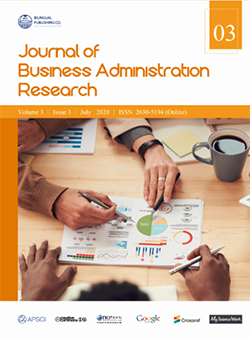Research on the Dynamic Relationships among Taiwan’s Early Childhood Education and Its Stakeholders: The System Dynamics Perspective
DOI:
https://doi.org/10.30564/jbar.v3i3.2107Abstract
In Taiwan, the low birth rate has become one of the most critical problems faced by the government and educational institutions at all levels.The enrolling student number of kindergartens perhaps is the most directly affected by such trend. The purpose of this study aims at constructing asystem dynamics model to depict the relationships between the preschoolchildren and their stakeholders for deducing the evolutionary trends of,and the interactions of, governmental policies and the operations of theearly childhood education institutions. Through the interpretation of policies and simulation analysis of the twenty-year growth trend related to thechild population in Taiwan, this study found that governmental policiesand the promotion of education and care services have a positive effect onthe growth of all levels of kindergarten classes. Besides, the relationshipbetween the education and care service staff and the kindergarten play acausal balancing role in our proposed model. We suggest that the systemdynamics model proposed by this study can help to observe the dynamicrelationships formed by the stakeholders in preschool education and caresystem based on the “joint responsibility” of Taiwan’s early childhoodeducation.Keywords:
Low birth rate; Early childhood education policy; Education and care service organization; The system dynamics perspective; Simulation analysisReferences
[1] Chen, T.-C., & Chen, K.-W., & Chung, P. C., & Lin, T. Y. (2018). Health and Welfare Policy Forum on Population Policy in Taiwan: Rethinking the Childcare Welfare Policy towards Children under 2 Years of Age. Journal of Population Studies, 57:125-136 (in Chinese).
[2] Executive Yuan (2020). The Website of Taiwan Executive Yuan, The Population of Taiwan: Land and People https://www.ey.gov.tw/state/99B2E89521FC31E1/835a4dc2-2c2d-4ee0-9a36-a0629a5de9f0(in Chinese, viewed on March 4, 2020).
[3] Chen, T.-Y., & Chen, M.-Y. (2019). Feasibility Analysis of Innovative Service Models in Childhood Education. Research of Educational Communications and Technology, 120:35-54 (in Chinese).
[4] Liao, C.-Y. (2012). Discussion on the supply and demand of preschool education in Taiwan in recent ten years. Boundless Treasure Academic Journal, 1:99-110 (in Chinese).
[5] Lin, S.-P., Chang, T.-F., & Wu, P.-L. (2007). Discussion on the influence of birth population decline on supply and demand of juvenile education. Journal of Elementary Education, 19:3-28(in Chinese).
[6] Yang, T.-Y.(2018). A brief discussion on the working pressure and coping strategies faced by elementary school teachers from the perspective of children reduction. Journal of Family Education Bimonthly, 74:66-71 (in Chinese).
[7] Duan, H. Y. (2011). Issues and changes of early childhood education development in China. Review and Prospect of country's 100-year Education, 185:105-120 (in Chinese).
[8] Weng, L.-F. (2012). On the development of Early childhood education in Taiwan from the perspective of Taiwan history. Educational Materials and Research, 104:1-26 (in Chinese).
[9] Chien, H.-C. (2011). The Study of Time Management for the Principal of Public Kindergarten. Yu Da Academic Journal, 27:35-64 (in Chinese).
[10] Oconnor, J., & McDemont, I. (1997). The Art of Systems Thinking: Essential Skills for Creativity and Problem Solving: San Francisco: Thorsins.
[11] Forrester, J. W. (1968). Industrial dynamics - a response to Ansoff and Slevin. Management Science, 14(9), 601-618.
[12] Forrester, J. W. (2016). Learning through System Dynamics as Preparation for the 21st Century. System Dynamics Review, 32:187-203.
[13] Barlas, Y. (1996). Formal aspects of model validity and validation in system dynamics. System Dynamics Review, 12(3):183-210.
[14] Sterman, J. D. (2000). Business dynamics: systems thinking and modeling for a complex world. New York: Doubleday Currency.
[15] National Development Council (2018). Estimation of population in the Republic of China (2018-2065). Journal of Agriculture and Forestry, 1:1-94 (in Chinese).
Downloads
Issue
Article Type
License
Copyright and Licensing
The authors shall retain the copyright of their work but allow the Publisher to publish, copy, distribute, and convey the work.
Journal of Business Administration Research publishes accepted manuscripts under Creative Commons Attribution-NonCommercial 4.0 International License (CC BY-NC 4.0). Authors who submit their papers for publication by Journal of Business Administration Research agree to have the CC BY-NC 4.0 license applied to their work, and that anyone is allowed to reuse the article or part of it free of charge for non-commercial use. As long as you follow the license terms and original source is properly cited, anyone may copy, redistribute the material in any medium or format, remix, transform, and build upon the material.
License Policy for Reuse of Third-Party Materials
If a manuscript submitted to the journal contains the materials which are held in copyright by a third-party, authors are responsible for obtaining permissions from the copyright holder to reuse or republish any previously published figures, illustrations, charts, tables, photographs, and text excerpts, etc. When submitting a manuscript, official written proof of permission must be provided and clearly stated in the cover letter.
The editorial office of the journal has the right to reject/retract articles that reuse third-party materials without permission.
Journal Policies on Data Sharing
We encourage authors to share articles published in our journal to other data platforms, but only if it is noted that it has been published in this journal.




 Tung-Shan Liao
Tung-Shan Liao

